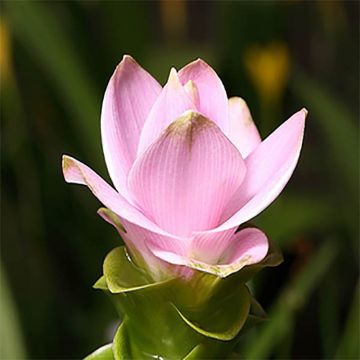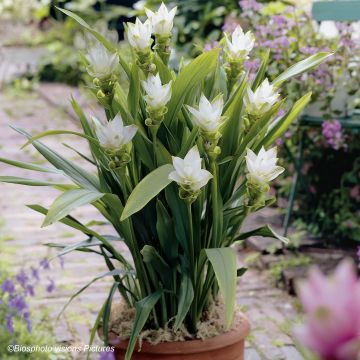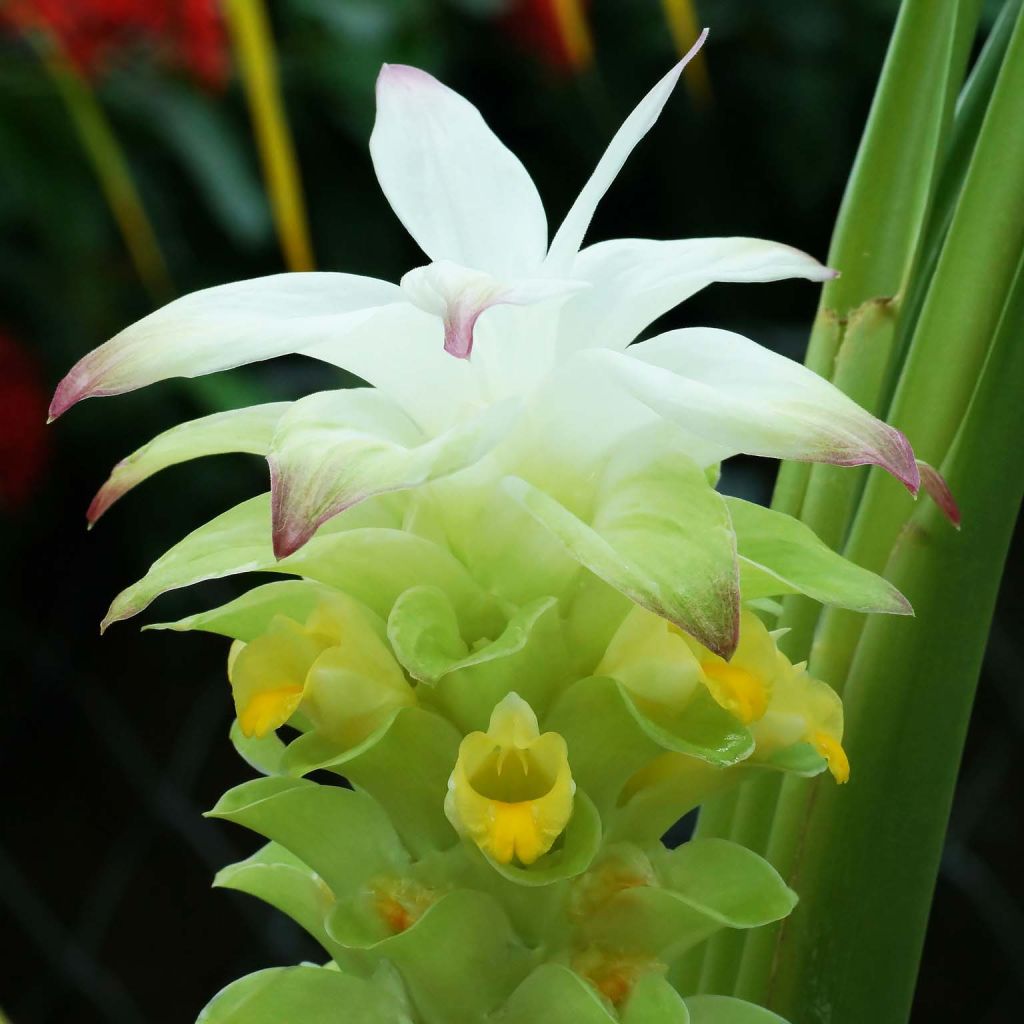

Curcuma longa - Common Turmeric
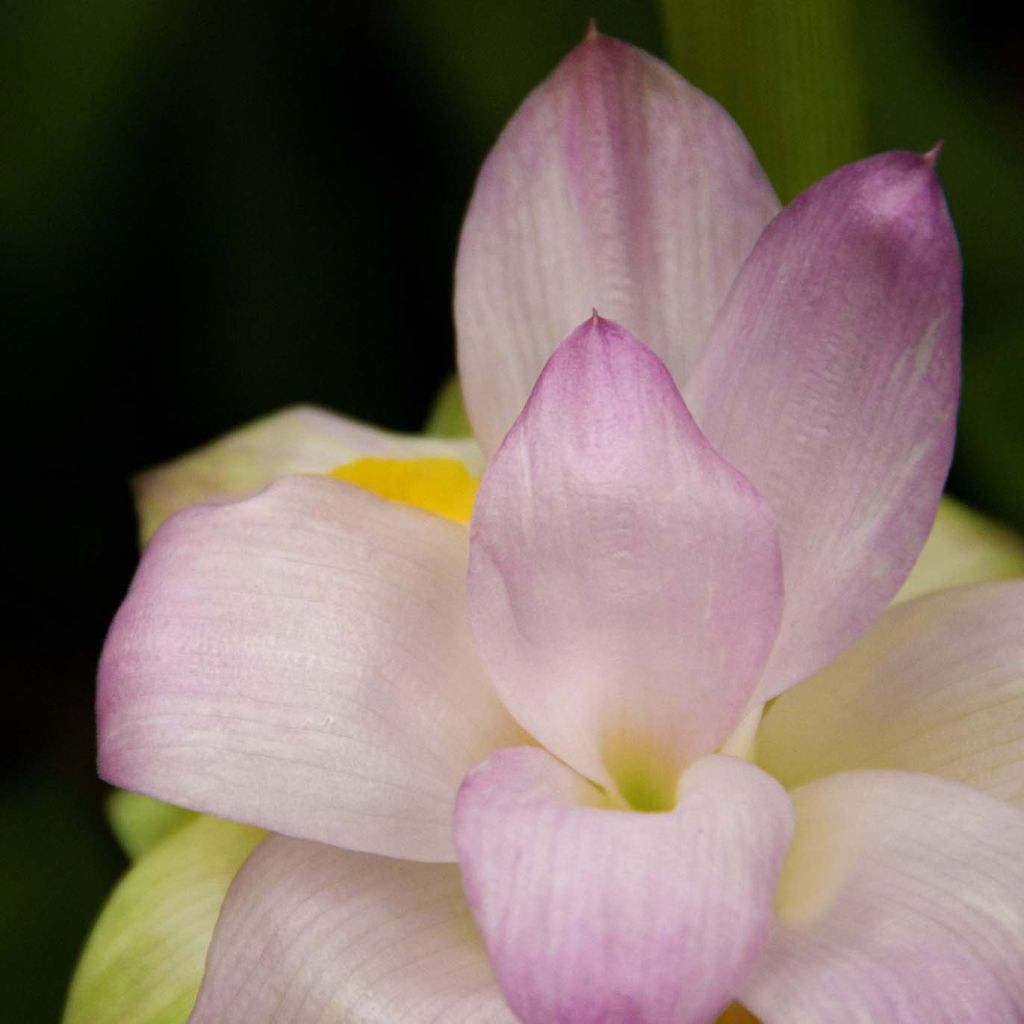

Curcuma longa - Common Turmeric
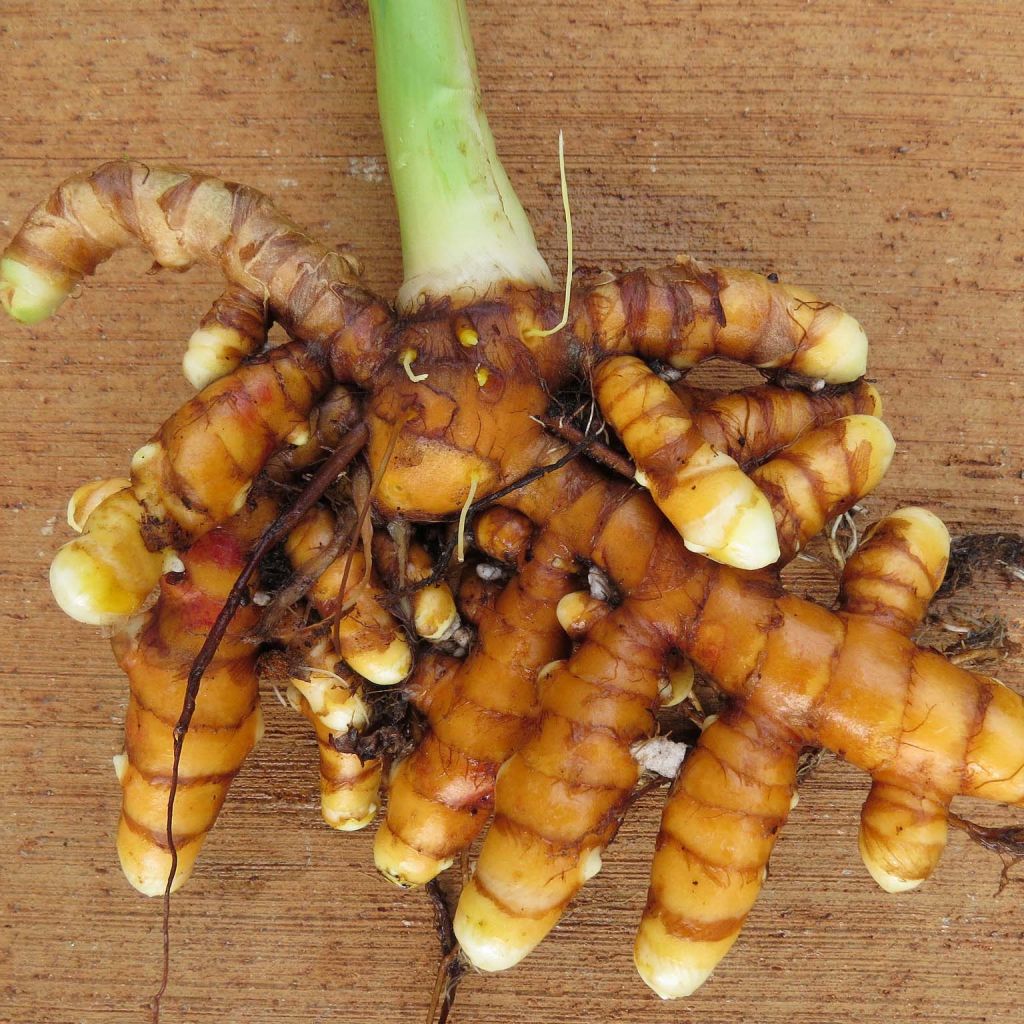

Curcuma longa - Common Turmeric
Curcuma longa - Common Turmeric
Curcuma longa
Turmeric, Indian Saffron
This plant carries a 12 months recovery warranty
More information
We guarantee the quality of our plants for a full growing cycle, and will replace at our expense any plant that fails to recover under normal climatic and planting conditions.
From €7.90 for pickup delivery and €6.90 for home delivery
Express home delivery from €8.90.

Does this plant fit my garden?
Set up your Plantfit profile →
Description
The Curcuma longa is much rarer in cultivation than its cousin, the Curcuma alismatifolia, often sold as an indoor plant under the name Thai Tulip. This plant, also known as Turmeric or Indian Saffron, is the aromatic, medicinal, and culinary plant from which the unique, peppery-flavoured orange spice used to flavour curry is extracted, as well as for its antioxidant properties in phytotherapy. This ginger relative is a tender plant that resembles a small banana tree but develops a decorative cream-pink flower spike. Cultivate it like a Dahlia in open ground or pots, as its rhizomes do not tolerate wet and frozen soils in winter. They are harvested at the end of summer when the foliage turns yellow.
Originating from southern or southeastern Asia, Curcuma longa (also known as Curcuma domestica) is a plant adapted to the monsoon, which means it is suited to climates with two seasons: the dry season, which corresponds to the resting period and the rainy season, which corresponds to the growth and flowering period. It is widely cultivated in India, as well as in China, Taiwan, Japan, Myanmar, Indonesia, and Africa. It has been subjected to extensive selection for a long time, to the extent that the existence of a wild species of Curcuma longa is questioned. It is a perennial plant through its rhizomes belonging to the Zingiberaceae family. Its annual growth usually emerges from the ground in April and disappears in autumn. The plant, with short stems, forms an upright clump that can reach a size of 1 m (3ft) by 50-60 cm (20-24in) wide. It grows from numerous aromatic rhizomes, cylindrical or ellipsoid and has a bright yellow to orange interior. Its broad leaves, oblong to elliptical, lanceolate, strongly veined, sheathing at the base, are alternately arranged on the stems in 2 rows. They can measure up to 50 cm (20in) long and 7 cm (3in) wide, and their colour is bright and relatively light green. The foliage has a subtle aroma that can be detected when crushed. All parts of the plant are edible.
Flowering occurs in summer in our climates: a flower spike up to 20 cm (8in) appears at the tip of each leafy stem. It comprises sterile flowers tinted mauve and yellow, surrounded by large bracts that are initially green and become white-cream washed with pink-violet at full bloom. Curcuma longa reproduces only through spontaneous propagation by its rhizomes.
Curcuma longa is ideal for adding a touch of exoticism and lushness to the garden. Planted in the sun alongside Cannas, Castor Beans, and Colocasia, the effect will be guaranteed! It will also find its place in a large pot or even in the vegetable garden alongside aromatic plants, but in a sunny location and in fertile soil that remains moist from spring to summer. If you want to make your turmeric, blanch the rhizomes first to peel them. Then, let them dry in the sun and grind them into powder.
Properties:
The rhizome of turmeric possesses numerous medicinal properties known for a long time in Asia. It is attributed with powerful anti-inflammatory and antidepressant properties and the ability to prevent Alzheimer's disease and certain cancers due to its antioxidant content. Curcumin, the active molecule in turmeric, is currently the subject of serious studies to confirm its properties.
Turmeric is also a dye plant responsible for colouring the costumes of Buddhist monks. It is also used in the food industry to give certain dishes a beautiful golden hue and exotic aroma.
The young shoots and flowers of Curcuma longa are used in Thai cuisine. The leaves are used to flavour fish dishes in Indonesia.
Report an error about the product description
Curcuma longa - Common Turmeric in pictures
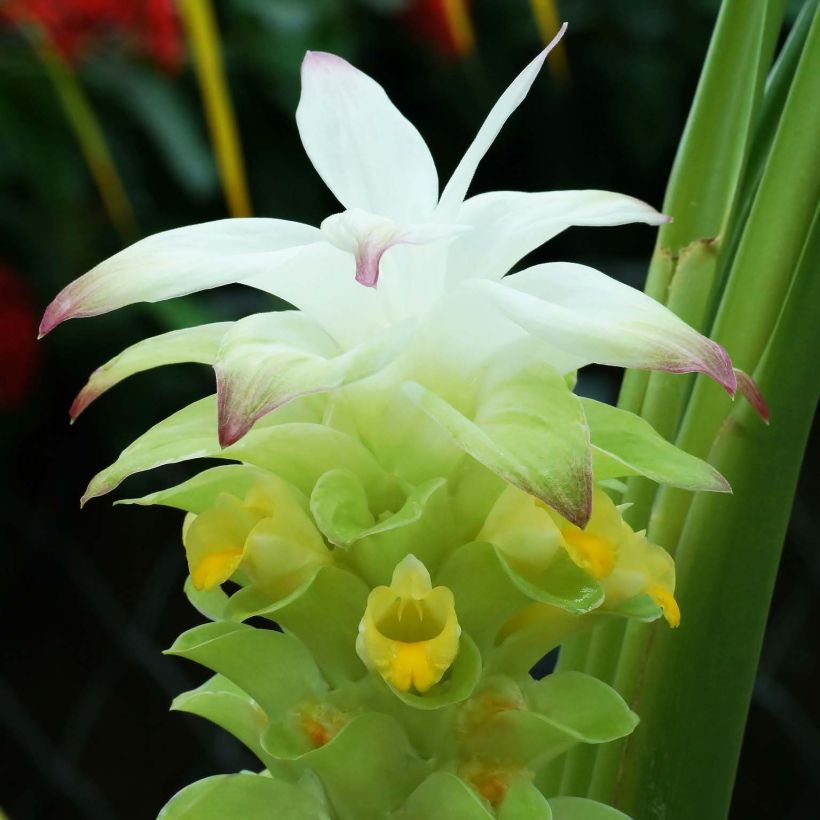

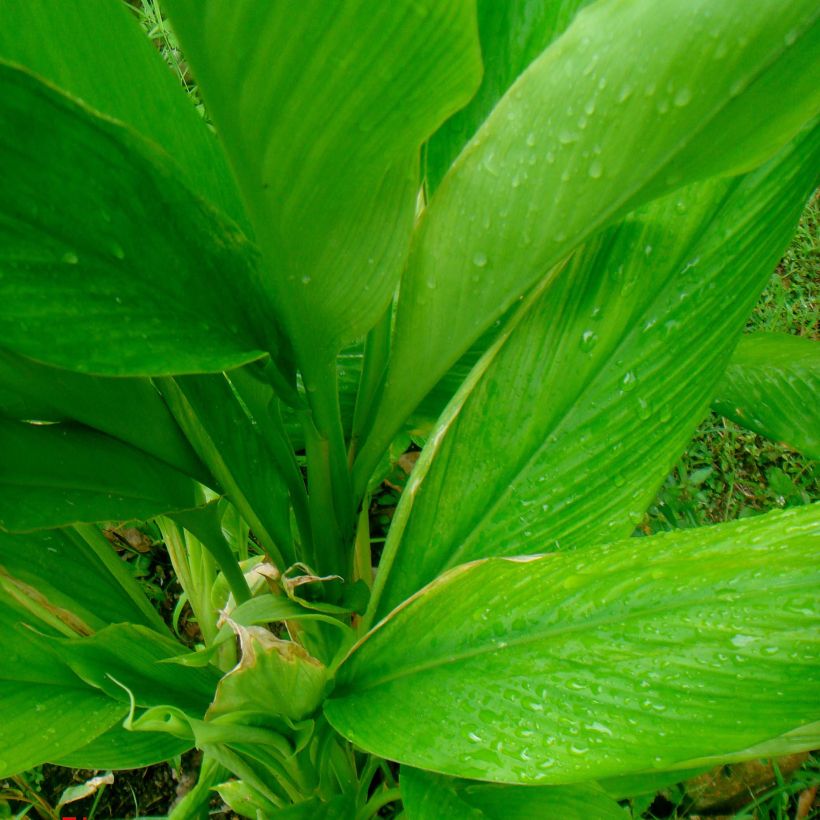

Flowering
Foliage
Plant habit
Botanical data
Curcuma
longa
Zingiberaceae
Turmeric, Indian Saffron
India
Other Curcuma - Turmeric
Planting and care
Curcuma longa requires sunlight and fertile, well-drained, and loose soil. It needs water throughout its growth period, from spring to the end of summer, but requires dry soil during its resting period in winter. In our climates, it is preferable to dig up the rhizomes at the end of the season and store them in dry sand to protect them from frost, similar to what we would do for Dahlias.
Plant it after the last frost in a very sunny and wind-sheltered location. Plant the rhizome at a depth of 5 or 6 cm (2in) and moisten the soil. It needs well-prepared soil, free from small stones or rocks, enriched with leaf compost, and remaining moist but well-drained. It is not demanding regarding soil type, but it is preferable to avoid excessively chalky soils. Mulching in summer helps effectively retain soil moisture. You can plant your rhizomes in pots, which should be regularly but not excessively watered throughout the growing season. Apply some liquid fertilizer every fifteen days from June to September. Outdoor cultivation should be reserved only for mild climates, considering that rhizomes do not like excessive humidity in winter. Apply compost or well-decomposed manure every spring. Be sure to protect the plant from slugs and snails, which are fond of young shoots and flower buds. This plant has no other enemies.
Indoors, avoid direct sunlight that could burn the leaves. Place a layer of clay pebbles at the bottom of the pot and use a well-draining mixture composed of 1/3 river sand and 2/3 leaf compost. Do not hesitate to mist the foliage in dry atmospheres, as this plant, which loves the monsoon, needs a certain level of atmospheric humidity. Apply geranium liquid fertiliser once a month until August-September. Stop watering and fertilising in September as soon as the leaves turn yellow.
Propagation: division should be done in spring by taking a portion of a rhizome with a dormant bud (an eye).
Planting period
Intended location
Care
-
, onOrder confirmed
Reply from on Promesse de fleurs
Haven't found what you were looking for?
Hardiness is the lowest winter temperature a plant can endure without suffering serious damage or even dying. However, hardiness is affected by location (a sheltered area, such as a patio), protection (winter cover) and soil type (hardiness is improved by well-drained soil).

Photo Sharing Terms & Conditions
In order to encourage gardeners to interact and share their experiences, Promesse de fleurs offers various media enabling content to be uploaded onto its Site - in particular via the ‘Photo sharing’ module.
The User agrees to refrain from:
- Posting any content that is illegal, prejudicial, insulting, racist, inciteful to hatred, revisionist, contrary to public decency, that infringes on privacy or on the privacy rights of third parties, in particular the publicity rights of persons and goods, intellectual property rights, or the right to privacy.
- Submitting content on behalf of a third party;
- Impersonate the identity of a third party and/or publish any personal information about a third party;
In general, the User undertakes to refrain from any unethical behaviour.
All Content (in particular text, comments, files, images, photos, videos, creative works, etc.), which may be subject to property or intellectual property rights, image or other private rights, shall remain the property of the User, subject to the limited rights granted by the terms of the licence granted by Promesse de fleurs as stated below. Users are at liberty to publish or not to publish such Content on the Site, notably via the ‘Photo Sharing’ facility, and accept that this Content shall be made public and freely accessible, notably on the Internet.
Users further acknowledge, undertake to have ,and guarantee that they hold all necessary rights and permissions to publish such material on the Site, in particular with regard to the legislation in force pertaining to any privacy, property, intellectual property, image, or contractual rights, or rights of any other nature. By publishing such Content on the Site, Users acknowledge accepting full liability as publishers of the Content within the meaning of the law, and grant Promesse de fleurs, free of charge, an inclusive, worldwide licence for the said Content for the entire duration of its publication, including all reproduction, representation, up/downloading, displaying, performing, transmission, and storage rights.
Users also grant permission for their name to be linked to the Content and accept that this link may not always be made available.
By engaging in posting material, Users consent to their Content becoming automatically accessible on the Internet, in particular on other sites and/or blogs and/or web pages of the Promesse de fleurs site, including in particular social pages and the Promesse de fleurs catalogue.
Users may secure the removal of entrusted content free of charge by issuing a simple request via our contact form.
The flowering period indicated on our website applies to countries and regions located in USDA zone 8 (France, the United Kingdom, Ireland, the Netherlands, etc.)
It will vary according to where you live:
- In zones 9 to 10 (Italy, Spain, Greece, etc.), flowering will occur about 2 to 4 weeks earlier.
- In zones 6 to 7 (Germany, Poland, Slovenia, and lower mountainous regions), flowering will be delayed by 2 to 3 weeks.
- In zone 5 (Central Europe, Scandinavia), blooming will be delayed by 3 to 5 weeks.
In temperate climates, pruning of spring-flowering shrubs (forsythia, spireas, etc.) should be done just after flowering.
Pruning of summer-flowering shrubs (Indian Lilac, Perovskia, etc.) can be done in winter or spring.
In cold regions as well as with frost-sensitive plants, avoid pruning too early when severe frosts may still occur.
The planting period indicated on our website applies to countries and regions located in USDA zone 8 (France, United Kingdom, Ireland, Netherlands).
It will vary according to where you live:
- In Mediterranean zones (Marseille, Madrid, Milan, etc.), autumn and winter are the best planting periods.
- In continental zones (Strasbourg, Munich, Vienna, etc.), delay planting by 2 to 3 weeks in spring and bring it forward by 2 to 4 weeks in autumn.
- In mountainous regions (the Alps, Pyrenees, Carpathians, etc.), it is best to plant in late spring (May-June) or late summer (August-September).
The harvesting period indicated on our website applies to countries and regions in USDA zone 8 (France, England, Ireland, the Netherlands).
In colder areas (Scandinavia, Poland, Austria...) fruit and vegetable harvests are likely to be delayed by 3-4 weeks.
In warmer areas (Italy, Spain, Greece, etc.), harvesting will probably take place earlier, depending on weather conditions.
The sowing periods indicated on our website apply to countries and regions within USDA Zone 8 (France, UK, Ireland, Netherlands).
In colder areas (Scandinavia, Poland, Austria...), delay any outdoor sowing by 3-4 weeks, or sow under glass.
In warmer climes (Italy, Spain, Greece, etc.), bring outdoor sowing forward by a few weeks.

































